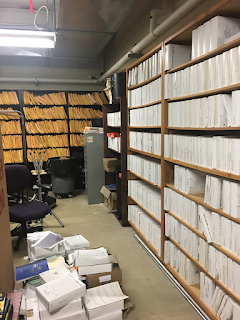The music department library houses hundreds of pieces of music in Howard
Deep in the basement of Howard Music Hall is the college’s lesser-known library, holding a collection of sheet music that dates back to the 1940s.
Professor of Music James Holleman, who directs the college orchestra and choirs, has been building the music library for 27 years.
“Since we have students in a four-year rotation, the music that we do is really connected and is standard repertoire that should be done by students when they’re in college,” Holleman said. “We don’t have to order it, we don’t have to buy it — it gets more expensive. We own it, and I can go and pull from it.”
Holleman said he buys about 35 copies for the chamber choir and 80 to 120 copies for the college choir, all of which show the full score of soprano, alto, tenor, and bass parts and accompaniment. For orchestra, he has to take into account different instruments.
“I order 12 first violins, 12 seconds, eight violas, eight cellos, four basses, and then you get all the winds, brass, percussion score, and then you file all that,” Holleman said.
Holleman said he enjoys having the library to loan music out and look at old music. He said there are many good options ranging from acapella and sacred music to secular and larger works.
“With the Chamber Choir this semester, I started pulling some of the pieces that just really went over well over the years,” Holleman said. “So I kind of joke that I’m starting my sort of Greatest Hits farewell tour.”
Holleman said he sometimes comes down to the library to scope out potential music for the next semester or next year.
“I’ll just come down here sometimes and put on my glasses — I just go through looking for titles and stuff will jump out at me,” Holleman said
The library contains original pieces like the Hillsdale fight song, alma mater, an overture for the orchestra written by Associate Professor of Music Daniel Tacke, and pieces by Andrew Maxfield that Hillsdale has premiered. The library also holds Russian music that is no longer available since the fall of the Soviet Union.
“There were periods of time where you could purchase certain Russian music, and then it got to where you couldn’t — where it was only rental or it was unavailable,” Holleman said. “So if we had purchased it when it was available, then we have it and we have rights to perform it. So we have a few pieces that you just can’t get anymore, or it’s difficult to get.”
Sophomore Samuel Jarzab and freshman Miriam Ahern work as librarians who organize the music library. They are responsible for printing copies if the music is public domain and letting Holleman know if the choir is short on ordered music.
Jarzab said he enjoys organizing and maintaining volumes of music.
“My favorite part is just helping the choir with whatever they need,” Jarzab said. “We’re there with extra copies of music, extra folders if someone forgets on a particular day. We’re managers as much as we are librarians.”
Jarzab said at the end of each concert cycle, he and Ahern collect the music to file away alphabetically by title until it can be recycled.
“It’s a little tedious, but nevertheless, it’s a great experience,” Jarzab said.
He estimates the library holds at least a few hundred pieces, with more being added by the chapel choir and the Tuesday night wind ensemble band.
“There are pieces going years and years back that we can still pull out,” Jarzab said.
Freshman Lydia Boone, a member of the college choir and orchestra, said the increasing size of choirs and orchestra may lead to the library’s further expansion.
“The music library seems to have a lot of stuff in it,” Boone said, “but not enough music for every student since choir and orchestra are growing.”
The moldiness of the paper and the different music presentation dates some pieces back to the 1950s, Holleman said.The differences range from individually flagged notes, rather than barred, to the use of diphthongs and vowels.
“The music written for choirs back then had that written out in phonetics below the text — it’s very confusing to look at it and read,” Holleman said. “I would order a new modern edition of the piece and put that in the library.”
Holleman said the alphabetical organization of the music, proposed by a student, took some getting used to, but a computer database allows him to see the number of copies of a piece.
“It’s functional because I’ve lived with it for 27 years,” Holleman said. “I kind of know where things are and where to look, and I remember what I bought, what I haven’t bought. It’s nothing like they would do up at Mossey Library — they would be embarrassed by our organizational system, but it works.”
The academic priorities of librarians come first, but there have been student employees organizing the library during the summer, according to Holleman.
“It’s just a matter of getting some students down here and just really rolling up their sleeves and trying to make it happen,” he said.
Jarzab said he enjoys looking through the sheet music as a part of his job as librarian.
“I know a lot of musicians are moving towards the iPad, having everything stored electronically, but for me, I love working with sheet music,” Jarzab said. “There’s an element of nostalgia.”
![]()

